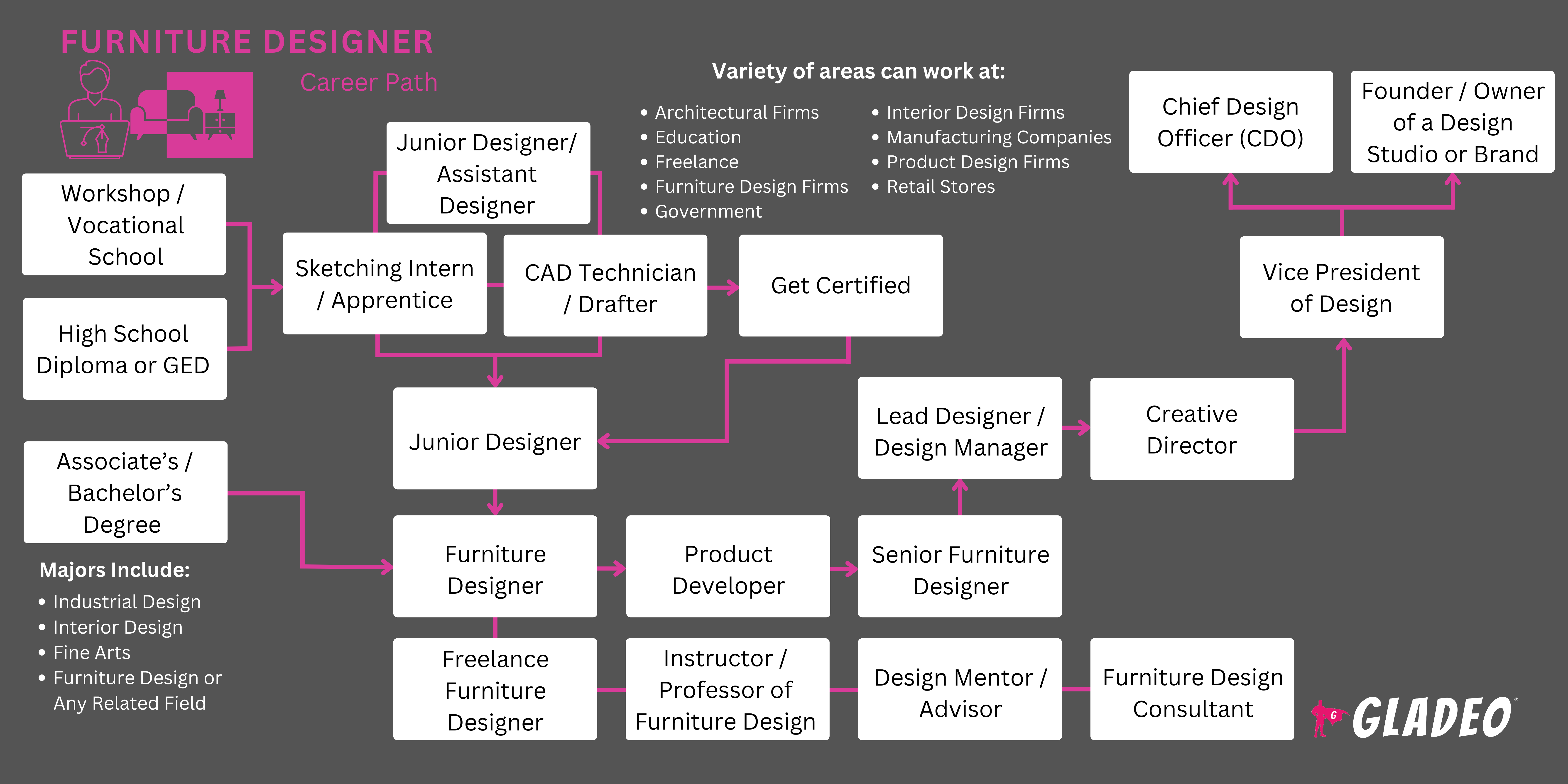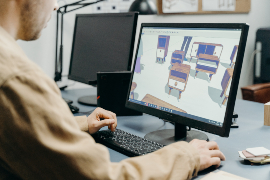Spotlights
Kỹ sư thiết kế, Nhà thiết kế, Nhà thiết kế công nghiệp, Nhà thiết kế cơ khí, Nhà thiết kế khuôn, Kỹ sư thiết kế sản phẩm, Nhà thiết kế sản phẩm, Kỹ sư phát triển sản phẩm, Nhà thiết kế ký hiệu
Are you reading this while sitting on a chair or sofa? If so, take a second to think about where that piece of furniture came from!
At some point, someone designed that product you’re sitting on. In fact, somebody designed every piece of furniture you’ve ever seen or used. Most of us never think about Furniture Designers–but without them, we’d have no chairs, sofas, tables, cabinets, bookshelves, beds, outdoor furniture, office furnishings, or similar items.
Furniture Designers create and develop functional furniture pieces that are practical and visually appealing. They research trends, sketch designs, select materials, and oversee manufacturing to ensure final products meet intended designs. They might start with a conceptual sketch of a chair, create a digital 3D model, and then work with craftsmen to choose suitable materials and production techniques. During the design stage, they consider variables such as ergonomics, space efficiency, and style.
Though their efforts are rarely recognized by the public, Furniture Designers contribute significantly to our interior spaces and make our lives much easier!
- Expressing creativity through functional products
- Seeing product designs be used in everyday settings
- Opportunities to work with various materials and techniques
Lịch làm việc
Furniture Designers may work full-time or part-time in design studios, workshops, or manufacturing facilities. They must frequently collaborate with clients and other design professionals.
Nhiệm vụ tiêu biểu
- Research and analyze trends in furniture design, materials, and manufacturers
- Conduct market research to identify opportunities for new product lines and design improvements
- Create custom furniture designs tailored to specific spaces and unique client needs
- Create concept sketches for original designs
- Select appropriate materials, finishes, and colors
- Calculate material, labor, and production costs to develop pricing strategies
- Develop concepts further using furniture design software and CAD tools (such as AutoCAD, SketchUp, or SolidWorks) to produce 2D and 3D models featuring dimensions and other specifications
- Review designs with stakeholders
- Collaborate with sales and marketing teams to ensure design concepts align with market demands
- Work with craftsmen and manufacturers to develop prototypes.
Provide detailed assembly instructions and material lists - Ensure prototypes meet specifications, as well as safety, ergonomic, and quality standards
- Oversee the production process of approved designs. Perform quality control checks on finished products
- Present and market designs to potential clients and retailers
Trách nhiệm bổ sung
- Stay updated with industry trends and new materials
- Integrate sustainable practices and eco-friendly materials into design processes
- Engage in continuous learning to refine design and technical skills
- Negotiate with suppliers for high-quality materials and competitive pricing
- Provide after-sales support, including product care, maintenance, and repair guidance
- Attend trade shows and exhibitions
- Maintain a portfolio of work to attract new clients and opportunities
Kỹ năng mềm
- Nghệ thuật
- Chú ý đến chi tiết
- Client relations
- Kỹ năng giao tiếp
- Tập trung vào người tiêu dùng
- Sáng tạo
- Suy luận suy diễn
- Kỹ năng tổ chức
- Kiên nhẫn
- Giải quyết vấn đề
- Tháo vát
- Làm việc theo nhóm
- Quản lý thời gian
Kỹ năng kỹ thuật
- Ergonomics, functionality, and user experience in furniture design
- Kiến thức về phần mềm liên quan đến:
- Analytics
- Thiết kế hỗ trợ máy tính
- Sản xuất có sự hỗ trợ của máy tính
- Môi trường phát triển
- Phân tích tài chính
- Đồ họa
- Materials, manufacturing processes, and construction techniques
- Problem-solving frameworks and lean product management
- Quản lý dự án
- Technical drawing and modeling skills
- Công ty kiến trúc
- Custom furniture workshops
- Freelance or independent design studios
- Furniture manufacturing companies
- Interior design firms
- Cửa hàng bán lẻ
- Thương mại bán buôn
Furniture must be visually pleasing, ergonomic, and durable because it gets used over and over, sometimes by multiple people. Thus, consumers expect companies to produce goods that will last.
Designers use a human-centered approach that puts consumer safety and needs first. In addition, they’re involved with quality assurance so products meet standards and are tested before hitting the market.
Meanwhile, furniture manufacturers are interested in keeping costs down, so designers must take this into account, too. The role requires balancing creativity with practicality, as well as managing time and budgets effectively.
Sustainability is a long-running trend in furniture design, with demand increasing for eco-friendly materials and production methods. Designers are also integrating smart features into many furniture products, blending functionality with technology to enhance user experience. Minimalism continues to be a popular aesthetic, so designers may frequently focus on clean lines, simplicity, and versatility.
Furniture Designers often have a passion for hands-on activities from a young age. They might have enjoyed drawing, building models, and woodworking.
- There are no formal educational requirements to enter this career field, but Furniture Designers typically complete a relevant certificate program, vocational school training, an associate degree, or a bachelor’s degree in industrial design, furniture design, or a related field
- Common courses might include:
- Applied Techniques
- CAD and Digital Modeling
- Concept to Object
- Design History and Principles
- Drawing Furniture 2D and 3D
- Ergonomics
- Furniture Final Project
- Industrial Design
- Introduction to Furniture
- Quy trình sản xuất
- Khoa học vật liệu
- Metals for Furniture Design
- Professional Practice and Portfolio
- Textiles
- Students should try to get as much hands-on practice as possible, through internships, apprenticeships, part-time jobs, volunteer work, or at-home practice
- Furniture Designers should also participate in continual learning through extra classes, workshops, and other events.
Check out local trade school catalogs and organizations like The Furniture Society and Industrial Designers Society of America for opportunities - Certification in programs like Autodesk AutoCAD or Rhino 3D can be very helpful for standing out
- Other useful programs to learn may include:
- CAD Pro
- eCabinet Systems
- Foyr Neo
- Fusion 360
- PRO100
- Rockler SketchList 3D Furniture Design Software
- Phác thảo
- SmartDraw
- CÔNG TRÌNH SOLIDWORKS
- Sweet Home 3D
- Vectorworks
- Wood Designer
- Woodwork for Inventor
- Compare tuition and other costs to be certain you’re getting the best value for your money.
- Think about the pros and cons of online versus on-campus learning. In some cases, a hybrid program might be most suitable so you can get hands-on practice.
- Read college program faculty bios to learn about their backgrounds and prior work.
- Look for programs that have internships with local manufacturers and design firms.
- Take plenty of classes in art, sculpture, graphic design, business, math, physics, drafting/computer-aided drafting, and woodwork or metalwork
- Study past and present furniture styles and think of ways you might alter or improve products
- Always keep ergonomics in mind, since most furniture must be functional and practical
- Sketch your ideas in notebooks or tablets for later reference and inspiration
- Read books, magazines (like Furniture World), and blogs about furniture and product design
- Watch video tutorials or sign up for ad hoc classes on sites like Udemy or Coursera
- Learn about the different types of furniture products out there, like chairs, sofas, cabinets, tables, dressers, desks, bookshelves, etc.
- Thực hành làm việc với phần mềm và công nghệ kỹ thuật số liên quan đến thiết kế sản phẩm
- Work on your portfolio so you can show off your talents to potential employers
- Make connections when doing internships
- Stay informed about contemporary design trends and techniques
- Network with professionals in the industry and seek mentorship.

- Search for job openings on employment portals like Indeed and ZipRecruiter
- Read posts carefully. Take note of any skills/experience gaps so you can work on those, if needed
- Write down keywords to add to your resume, such as:
- 3D Modeling
- Phần mềm CAD
- Creative Conceptualization
- Ergonomics
- Quy trình sản xuất
- Market Trends Analysis
- Materials Knowledge
- Product Development
- Prototyping
- Sustainable Design
- Check out Furniture Designer resume templates for ideas
- Tham khảo trung tâm hướng nghiệp của trường bạn để được trợ giúp viết sơ yếu lý lịch, thực hành các kỹ thuật phỏng vấn và kết nối với các nhà tuyển dụng
- Liên hệ với các cựu giám sát viên và giáo sư để hỏi xem họ có đóng vai trò là tài liệu tham khảo cá nhân không
- Đánh bóng danh mục đầu tư trực tuyến của bạn và chứa đầy những bức ảnh chất lượng cao và các chi tiết mô tả thể hiện kỹ năng thiết kế trực quan và tương tác và sự sáng tạo của bạn
- Participate in design competitions and exhibitions to showcase your work
- Expect to start as an intern or assistant designer
- Turn in product designs that are feasible and profitable
- Stay within budgets and timeframes
- Stay open to constructive criticism
- Be a team player who collaborates well with others
- Demonstrate leadership skills and take on additional responsibilities
- Stay on top of furniture design trends (see our list of Recommended Resources)
- Knock out additional training and certifications to hone your skills or learn new ones
- Consider completing a master’s degree program. Like the Rhode Island School of Design’s Master of Fine Arts in Furniture Design
- Stay in touch with your network and keep an eye out for opportunities
- Participate in trade shows, design exhibitions, and professional organization events
- Continue to develop your online presence to show off your work
- Move to where the most jobs are. Per BLS, the states with the highest employment for commercial and industrial designers are California, New York, Michigan, Florida, and Ohio
Các trang web
- Viện Nghệ thuật Đồ họa Hoa Kỳ
- Architonic
- Autodesk AutoCAD
- Autodesk Fusion
- CAD Pro
- Core77
- Designboom
- Design Milk
- Dezeen
- Domus
- Cư
- eCabinet Systems
- Foyr Neo
- Furniture Today
- Houzz
- Yếu tố con người và xã hội công thái học
- Hiệp hội các nhà thiết kế công nghiệp Hoa Kỳ
- Inhabitat
- Hiệp hội thiết kế tương tác
- Interior Design Magazine
- InteriorZine
- Material ConneXion
- PRO100
- Hiệp hội quản lý và phát triển sản phẩm
- Rhino 3D
- Rockler SketchList 3D
- Phác thảo
- SmartDraw
- CÔNG TRÌNH SOLIDWORKS
- Sweet Home 3D
- The Design Edit
- The Furniture Society
- Vectorworks
- Wood Designer
- Woodwork for Inventor
- Tổ chức thiết kế thế giới
- Yanko Design
Sách vở
- Atlas of Furniture Design, by Mateo Kries, et. al.
- Furniture Design, by Jim Postell
- Furniture Design: An Introduction to Development, Materials and Manufacturing, by Stuart Lawson
- The COMPLETE BOOK of Product Design, Development, Manufacturing, and Sales, by Steven Selikoff
- The Furniture Bible: Everything You Need to Know to Identify, Restore & Care for Furniture, by Christophe Pourny
- Woodworker’s Guide To Furniture Design, by Garth Graves
Furniture design can be a rewarding field, but workers don’t always get public recognition for their creative efforts. If you’re curious about related careers, check out our list below!
- Kiến trúc sư
- Giám đốc nghệ thuật
- Kỹ thuật viên CAD
- Design Consultant
- Thợ sửa chữa
- Nhà thiết kế thời trang
- Nhà thiết kế đồ họa
- Nhà thiết kế công nghiệp
- Nhà thiết kế nội thất
- Set Designer
- Lập trình viên
- Sports Product Designer
- Nghệ sĩ hiệu ứng hình ảnh (VFX)
- Thợ mộc
Nguồn cấp tin tức

Công việc nổi bật

Các khóa học và công cụ trực tuyến

Kỳ vọng mức lương hàng năm
New workers start around $46K. Median pay is $67K per year. Highly experienced workers can earn around $91K.





